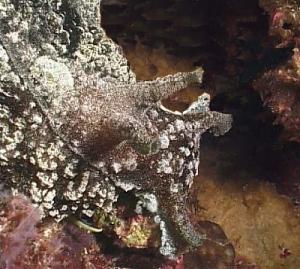Dolabella auricularia from Solomon Ids
October 13, 2000
From: Bruce Potter


Bill,
I was diving in the Russell group of the Solomon Islands last weekend, and on a site known as East Mane, I found a slug I have been looking for for years. It was a Dolabella auricularia.
The odd thing about this find was that it was nine meters down a shear wall. At one stage as it was moving about, it's disproportionate rear end fell of the wall, and it was only saved from falling by holding on by its front end. I have always understood that it inhabits flat sites.
It was quite large at about 45-50 cm. There was plenty of algae and green stuff on the site.
Bruce Potter.
bruce.potter@adventist.org.sb
Potter, B., 2000 (Oct 13) Dolabella auricularia from Solomon Ids. [Message in] Sea Slug Forum. Australian Museum, Sydney. Available from http://www.seaslugforum.net/find/3159Dear Bruce,
The only rule of thumb about where sea slugs are likely to occur is that if their food is there there is always a chance. Dolabella are hardly the most graceful of animals and as you describe are often caught off balance. I have even found Bursatella leachi which is usually found on flat sandy or muddy bottoms, crawling over rocky regions, usually after wet weather when ther is a lot of silt settling out of the water.
best wishes,
Bill Rudman.
Related messages
-
Re: Suitability of Dolabella auricularia in an aquarium
From: Jorgen Svard, March 8, 2010 -
Dolabella auricularia diet
From: Keith Teller, November 16, 2009 -
Re: Dolabella auricularia from Tonga
From: Alastair Robertson, October 13, 2009 -
Re: Marine Spaghetti from the Philippines
From: Lorraine M. Cueva, September 25, 2009 -
Unknown from Camden Haven, New South Wales
From: Samson Kwok, January 9, 2009 -
Dolabella auricularia from Mozambique
From: Valda Fraser, April 14, 2008 -
Sea hare from Port Hacking, Sydney
From: David Robertson, April 7, 2008 -
Dolabella from South Africa
From: Waldo Nell, August 16, 2006 -
Re: Lukot - Marine Spaghetti from the Philippines
From: Richard Parker, August 3, 2006 -
Lukot - Marine Spaghetti from the Philippines
From: Richard Parker, August 1, 2006 -
Is Dolabella auricularia hermaphrodite?
From: Gary Majchrzak, July 10, 2006 -
Dolabella auricularia from Forster, NSW.
From: Colin Malakou, March 23, 2006 -
Re: Is my sea hare sick?
From: Brian Vastag, July 19, 2005 -
Dolabella auricularia from Sth Korea
From: Dong Bum Koh, July 18, 2005 -
Is my sea hare sick?
From: Brian Vastag, July 18, 2005 -
Dolabella auricularia from Natal
From: Gerda du Raan, June 6, 2005 -
Dolabella auricularia in aquarium
From: Tomoko Schum, February 8, 2005 -
Sea Hare from Hawaii
From: Lyudmila Zinkova , December 23, 2004 -
Dolabella auricularia from Sydney Harbour
From: Greg Braun, August 11, 2004 -
Re: Sea Hares
From: Tom and Jack Burrows, February 4, 2004 -
Sea slugs?
From: Tom and Jack Burrows, February 3, 2004 -
Dolabella auricularia from Red Sea
From: Isabelle Drouet, January 22, 2004 -
Suitability of Dolabella auricularia in an aquarium
From: Carolyn Bryce, December 6, 2003 -
Inking behavior in Dolabella auricularia
From: Jaron Brown, October 3, 2003 -
Dolabella auricularia in the South China Sea
From: Kheong San Chang, April 17, 2003 -
Re: Dolabella - Captive breeding
From: Cathryn Clarke, March 31, 2003 -
Dolabella auricularia captive breeding
From: Hervé, March 29, 2003 -
Dolabella auricularia from the Philippines
From: Anevi Gunday, February 6, 2003 -
Dolabella auricularia from Lord Howe Island
From: W.B. Rudman, January 30, 2003 -
Dolabella auricularia and egg masses
From: Rachel Przeslawski, January 14, 2003 -
Re: Growth stages in Dolabella auricularia
From: Alicia Hermosillo, January 4, 2003 -
Re: Growth stages in Dolabella auricularia
From: Alicia Hermosillo, January 2, 2003 -
Re: Dolabella juveniles
From: Mary Jane Adams, January 2, 2003 -
Growth stages in Dolabella auricularia
From: Mary Jane Adams , January 1, 2003 -
Dolabella auricularia in the Philippines
From: Jonathan P. Ubaldo, December 5, 2002 -
EU survey of Dolabella
From: Kim Friedman , September 23, 2002 -
Aplysiid from Bahia de Banderas
From: Alicia Hermosillo, September 13, 2002 -
About dolastatines
From: Denis Berlemont, July 6, 2002 -
Dolabella auricularia from Sth Korea
From: Dong Bum, Koh, June 28, 2002 -
Natural history of Dolabella auricularia
From: Sheena, March 5, 2002 -
Dolabella auricularia from Japan
From: Nishina Masayoshi , November 5, 2001 -
Where can we find Dolabella
From: T. Thiru, September 15, 2001 -
Chemical defense in Dolabella
From: Julia Brooke, April 8, 2001 -
Diet of Dolabella auricularia
From: Arnaud Parenty, March 28, 2001 -
Re: Dolabella auricularia and burrowing
From: Don Barclay, March 19, 2001 -
Dolabella auricularia and burrowing
From: Don Barclay, March 17, 2001 -
Dolabella auricularia - source of new drug
From: Arnaud Parenty, February 24, 2001 -
Re: Sea Hare eggs
From: Nerissa Bontia, October 14, 2000 -
Aplysiid egg compounds
From: Kirsten Benkendorff, September 22, 2000 -
Sea Hare eggs
From: Nerissa Bontia, September 21, 2000 -
Re: Dolabella as food
From: Claudia Armann, July 23, 1999 -
Dolabella auricularia research
From: Sandeep K. Singh, June 22, 1999 -
Dolabella egg masses
From: Erwin Koehler, April 1, 1999 -
Re:Dolabella in Fiji - as food etc
From: Veikila Vuki, March 17, 1999 -
Re:Dolabella research in Fiji
From: Sandeep K. Singh, March 16, 1999 -
Re: Dolabella in Fiji
From: Sandeep K. Singh, March 16, 1999 -
Dolabella research in Fiji
From: Dr. Veikila Vuki, March 10, 1999
